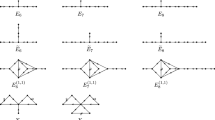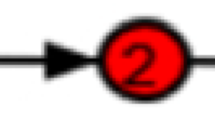Abstract
This if the final paper in the series Continuous Quivers of Type A. In this part, we generalize existing geometric models of type A cluster structures for the new E-clusters introduced in part (III). We also introduce an isomorphism of cluster theories and a weak equivalence of cluster theories. Examples of both are given. We use these geometric models and isomorphisms of cluster theories to begin classifying continuous type A cluster theories. We also introduce a continuous generalization of mutation. This encompasses mutation and (infinite) sequences of mutation. Then we link continuous mutation to our earlier geometric models. Finally, we introduce the space of mutations which generalizes the exchange graph of a cluster structure, and show that paths in this space are continuous mutations.
Similar content being viewed by others
Data Availability
The author did not collect or produce any data. Thus there is no data to make available.
References
Fomin, S., Zelevinksy, A.: Cluter algebras I: Foundations. J. Am. Math. Soc. 15(15), 497–529 (2002). https://doi.org/10.1090/S0894-0347-01-00385-X
Golden, J.K., Goncharov, A.B., Spradlin, M., Vergud, C., Volovicha, A.: Motivic amplitudes and cluster coordinates. J. High Energy Phys. 2014 (1), 91 (2014). https://doi.org/10.1007/JHEP01(2014)091
Buan, A., Marsh, B., Reineke, M., Reiten, I., Todorov, G.: Tilting theory and cluster combinatorics. Adv. Math. 204(2), 572–618 (2006). https://doi.org/10.1016/j.aim.2005.06.003
Caldero, P., Chapoton, F., Schiffler, R.: Quivers with Relations Arising From Clusters (an Case). Trans. Am. Math. Soc. 358 (3), 1347–1364 (2006). https://doi.org/10.1090/S0002-9947-05-03753-0
Holm, T., Jørgensen, P.: On a cluster category of infinite Dynkin type, and the relation to triangulations of the infinity-gon. Math. Z 270(1), 277–295 (2012). https://doi.org/10.1007/s00209-010-0797-z
Baur, K., Graz, S.: Transfinite mutations in the completed infinity-gon. J. Comb. Theory Ser. A 155, 321–359 (2018). https://doi.org/10.1016/j.jcta.2017.11.011
Fomin, S., Shapiro, M., Thurston, D.: Cluster algebras and triangulated surfaces. Part I: Cluster complexes. Acta Math 201, 83–146 (2008). https://doi.org/10.1007/s11511-008-0030-7
Amiot, C.: Triangulated categories, equivalences and topological models. Representation Theory [math.RT], Université Grenoble-Alpes. https://hal.archives-ouvertes.fr/tel-03279648/document (2021)
Igusa, K., Todorov, G.: Continuous cluster categories I. Algebras Represent. Theory 18(1), 65–101 (2015). https://doi.org/10.1007/s10468-014-9481-z
Arkani-Hamed, N., Bai, Y., He, S., Yan, G.: Scattering Forms and the Positive Geometry of Kinematics, Color and the Worldsheet. J. High Energy Phys. (5) (2017)
Serhiyenko, K., Bennett, M.S., Williams, L.: Cluster structures in Schubert varieties in the Grassmannian. Proc. Lond. Math. Soc. 119(6), 1694–1744 (2019). https://doi.org/10.1112/plms.12281
Liu, Y., Zhou, P.: Abelian categories arising from cluster tilting subcategories II: quotient functors. Proceedings of the Royal Society of Edinburgh Section A Mathematics (2019)
Liu, Y., Zhou, P.: Abelian categories arising from cluster tilting subcategories. Applied Categorical Structures (2020)
Arkani-Hamed, N., He, S., Salvatori, G., Thomas, H.: ABCDs of Causal Diamonds, Cluster Polytopes and Scattering Amplitudes. arXiv:1912.12948 [hep-th]. https://doi.org/10.48550/arXiv.1912.12948 (2019)
Kulkarni, M.C., Matherne, J.P., Mousavand, K., Rock, J.: A Continuous Associahedron of type A. arXiv:2108.12927 [math.RT]. https://doi.org/10.48550/arXiv.2108.12927 (2021)
Igusa, K., Rock, J.D., Todorov, G.: Continuous Quivers of Type A (I) Foundations. Rendiconti del Circolo Matematico di Palermo Series, 2 (2022)
Rock, J.D.: Continuous Quivers of Type A (II) The Auslander–Reiten Space. arXiv:1910.04140v1 [math.RT]. https://doi.org/10.48550/arXiv.1910.04140 (2019)
Igusa, K., Rock, J.D., Todorov, G.: Continuous quivers of type a (III) embeddings of cluster theories. Nagoya mathematical journal (2022)
Igusa, K., Todorov, G.: Continuous cluster categories of type D. arXiv:1309.7409 [math.RT]. https://doi.org/10.48550/arXiv.1309.7409 (2013)
Hanson, E.J., Rock, J.D.: Decomposition of pointwise finite-dimensional \( \mathbb {S}^{1}\) Persistence Modules. arXiv:2006.13793v2 [math.RT]. https://doi.org/10.48550/arXiv.2006.13793 (2020)
Botnan, M. B., Crawley-Boevey, W.: Decomposition of persistence modules. Proc. Am. Math. Soc. 148, 4581–4596 (2020). https://doi.org/10.1090/proc/14790
Garcia, M., Igusa, K.: Continuously triangulating the continuous cluster category. Topol. Applic. 285, 107411 (2020). https://doi.org/10.1016/j.topol.2020.107411
Jørgensen, P., Yakimov, M.: c-vectors of 2-Calabi–Yau categories and Borel subalgebras of \(\mathfrak {sl}_{\infty }\). Sel. Math. (N.S.) 26 (1), 1–46 (2020). https://doi.org/10.1007/s00029-019-0525-4
Buan, A.B., Iyama, O., Reiten, I., Scott, J.: Cluster structures for 2-Calabi–Yau categories and unipotent groups. Compos. Math. 45(4), 1035–1079 (2009). https://doi.org/10.1112/S0010437X09003960
Rock, J.D.: Cluster Theories and Cluster Structures of Type A. arXiv:2112.14795 [math.RT]. https://doi.org/10.48550/arXiv.2112.14795 (2022)
Barnard, E., Gunawan, E., Meehan, E., Schiffler, R.: Cambrian combinatorics on quiver representations (type \(\mathbb {A}\)). Adv. Appl. Math. 143. https://doi.org/10.1016/j.aam.2022.102428 (2022)
Acknowledgements
The author was partly supported by Brandeis University during their graduate studies and partly supported by UGent BOF grant BOF/STA/201909/038 and FWO grants G023721N and G0F5921N. The author thanks Kiyoshi Igusa and Gordana Todorov for their guidance and support, Ralf Schiffler for organizing the Cluster Algebra Summer School in 2017 where this series was conceived, and Eric J. Hanson for helpful discussions. Finally, the author thanks the anonymous reviewer for careful reading and numberous helpful suggestions, especially regarding the clarity of figures.
Author information
Authors and Affiliations
Corresponding author
Ethics declarations
Competing interests
The author has no competing interests to declare that are relevant to the content of this article.
Additional information
Presented by: Michela Varagnolo
Publisher’s Note
Springer Nature remains neutral with regard to jurisdictional claims in published maps and institutional affiliations.
Rights and permissions
Springer Nature or its licensor holds exclusive rights to this article under a publishing agreement with the author(s) or other rightsholder(s); author self-archiving of the accepted manuscript version of this article is solely governed by the terms of such publishing agreement and applicable law.
About this article
Cite this article
Rock, J.D. Continuous Quivers of Type A (IV). Algebr Represent Theor 26, 2255–2288 (2023). https://doi.org/10.1007/s10468-022-10175-w
Received:
Accepted:
Published:
Issue Date:
DOI: https://doi.org/10.1007/s10468-022-10175-w




